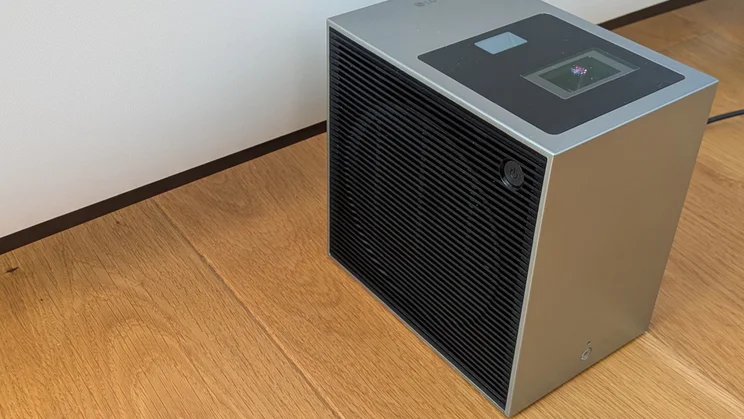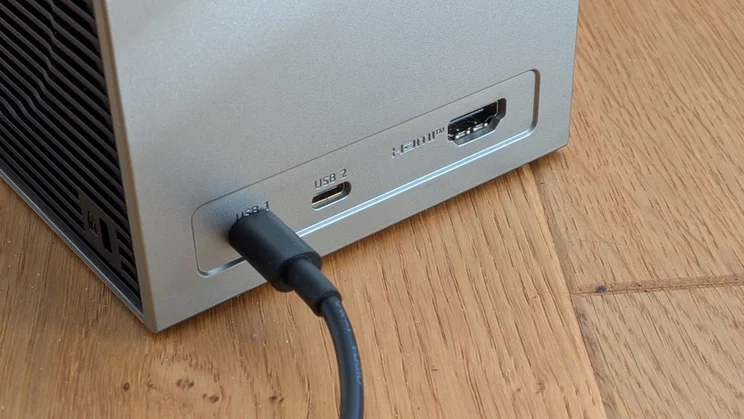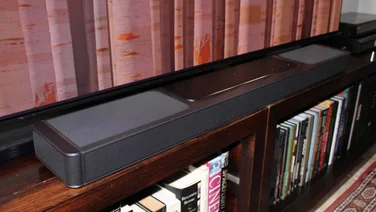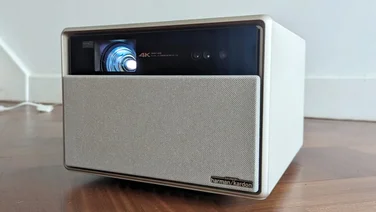To help us provide you with free impartial advice, we may earn a commission if you buy through links on our site. Learn more





- Ultra-short throw combined with compact style
- Stellar colour performance
- Easy to set up
- Thin and harsh audio
- Limited brightness levels
- Issues with auto-alignment and focus on some screens
The LG CineBeam S takes the increasingly popular compact projector format and twists it so ingeniously that you’re surprised nobody (I think) has done it before. This thing is tiny, packing a 4K laser projection system into a box only just over 16cm tall and under 11cm wide. But where most compact models need a couple of metres from the screen to produce a decent-sized picture, the CineBeam S has an ultra-short throw and can do it from roughly 8 to 40cm away.
This, in my opinion, makes it a potential game-changer for small spaces. Got a small living room with barely enough space to swing a cat? You can still have a 100in 4K picture, provided you’ve got a wall big enough to mount the screen. Plus, with built-in streaming and stereo sound, you don’t need to find room for anything else. However, it’s the kind of idea that stands or falls on the execution. Get it right, and you have a groundbreaking projector. Get it wrong, and you’ve got something that’s tough to recommend.
What do you get for the money?
The CineBeam S is a very compact 4K projector that costs £1,099 and measures 110 x 160 x 160mm (WDH). It combines a 4K triple-laser and DLP imaging system with a 0.25:1 ultra-short-throw lens, giving you a 40in picture from 8.1cm from the screen and a 100in picture from just over half a metre. Beyond this, you have a maximum brightness of 500 lumens and a claimed 154% DCI-P3 wide colour gamut, meaning image quality promises to be good.





The CineBeam S features LG’s WebOS software, as found in its smart TVs, giving you access to a wide range of streaming apps. Meanwhile, you have two 4W speakers supported by Dolby Atmos processing. It also supports HDR, though not the more advanced Dolby Vision standard, along with Filmmaker mode. A single HDMI 2.0 port has you covered for connecting Blu-ray players, external media streamers and consoles, while there are two USB Type-C ports, one for display connectivity and one for power. There’s no internal battery, so you’ll need the chunky power brick connected at all times.
What does it do well?
The CineBeam S uses the same WebOS UI as LG’s TVs, and it makes for a very TV-like experience, with an easy setup once you’ve connected to your network. The major UK streaming apps are supported, though weirdly none of the catch-up TV services, with no iPlayer, Channel 4, Channel 5 or ITVX apps onboard. Still, apps update quickly and automatically, and it’s quick and easy to switch between apps, particularly the five – Netflix, Amazon Prime Video, Disney+, Ratuken TV and LG Channels – with hotkeys on the compact black remote.
LG has also designed the projector with convenience and ease-of-use in mind. Put it against a wall or in front of a screen and it nearly always gives you a solid, well-aligned and crisp-looking 4K image, though it’s definitely at its best with a good screen to work with. Move the projector and it realigns automatically and almost instantly, if not quite as speedily as the Epson LifeStudio Flex EF-72. There’s even a tool to adjust the image to handle different coloured walls, with the colour balance shifting to compensate.





Most of all, the CineBeam S exceeded my expectations when it comes to image quality. 500 lumens really isn’t all that bright by the standards of most 4K projectors, but movies and high-budget binge TV series look sharp with exceptionally strong and vivid colours, especially at 50in to 80in screen sizes. Blacks are surprisingly dark, meaning there’s some contrast to work with, and HDR content looks surprisingly good, with plenty of shadow detail and some vibrant, colourful highlights. The different image presets give you some scope for picture tuning, with slightly more subdued and natural tones in the Cinema Home and Cinema modes, though Filmmaker mode errs a little towards being too dark and gloomy.
Watching Furiosa: A Mad Maxy Story, Star Trek: Strange New Worlds, House of Guiness and Interview with the Vampire, I was struck by how punchy and detailed the picture looks, particularly given the size and limited brightness level. Animations like Star Wars: Visions and Spider-Man: Across the Spider-Verse are practically bursting with richly saturated hues. Even games come out well, thanks to a low-latency and highly configurable game mode, complete with a custom control panel and ALLM support.





Running technical tests, I was positively gobsmacked to see the CineBeam S deliver colour performance almost in line with LG’s claims. 93.8% coverage of DCI-P3 with a 107% gamut volume is phenomenal by the standard of any projector, let alone such a compact model. Ditto for the 97.4% sRGB coverage with a 152% gamut volume. On this count, the CineBeam S is punching way above its weight.
What could it do better?
The limited brightness still has an impact. At further distances with bigger screens, the image loses some of its vibrancy and a smidgeon of its sharpness, meaning it falls behind bigger, brighter options like the XGIMI Horizon S Pro and the BenQ GP520. What’s more, it really only works in a dark room. Add much ambient light to the mix, and it’s hard to get a semi-decent picture.
I also encountered some issues with the auto-focus and alignment, where with some screens – particularly a tripod screen – it couldn’t seem to recognise the position of the top corners and get a stable picture. As a result, the image would periodically start shifting in the middle of a film or programme as the projector auto-adjusted to straighten up the picture. After a while, I ran the auto-setup, then turned the automatic option off, so that it wouldn’t go into action and spoil the show.





While LG’s software is generally easy to use, I found some of its more advanced controls tricky to find and unintuitive to use, which isn’t a problem when everything is working, but becomes one when things start going pear-shaped. It would also be nice to have backlit keys on the slimline remote, as it’s not always easy to remember the layout when you’re working in the dark.
It’s also odd that none of the catch-up TV apps come installed, when they’re a given with LG’s TVs, which run the same software. Presumably, it’s a licensing problem, but if so, it’s one LG needs to fix.
Perhaps the biggest issue here, though, is the audio. Sure, the CineBeam S can go much louder than you might expect, with a spread that can really fill a room. It’s very clear as well, making it easy to hear dialogue even in a busy scene. However, the output starts thin at lower volume levels and grows really harsh as you push them upwards, to the extent that I found action films like John Wick 3: Parabellum or Furiosa hard on the old lugholes. Watch music videos on YouTube, and it’s clear that there’s not much in the way of warmth or bass. Some compact projectors are really making great strides on the sound front, but the CineBeam S is not one of them.
Should you buy the LG CineBeam S?
Here’s my problem: I really want to love the CineBeam S. I think the whole concept is ingenious, and the answer to a lot of problems some of us have using projectors in small spaces. And while the brightness levels aren’t ideal, the picture can be really good, and the colour performance is exemplary.
Yet the limited brightness, harsh audio and minor usability issues work together to make it less effective as a compact projector than it really needs to be, and comparisons with similar models from Anker, BenQ and XGIMI don’t do it any favours. I still think that, with some tweaks and improvements, this could be a miniature marvel, but – right now – it’s falling short.







